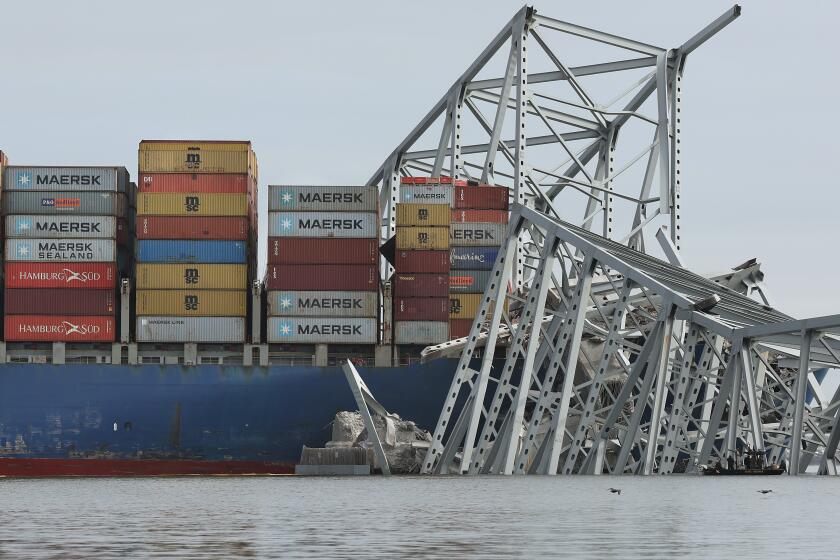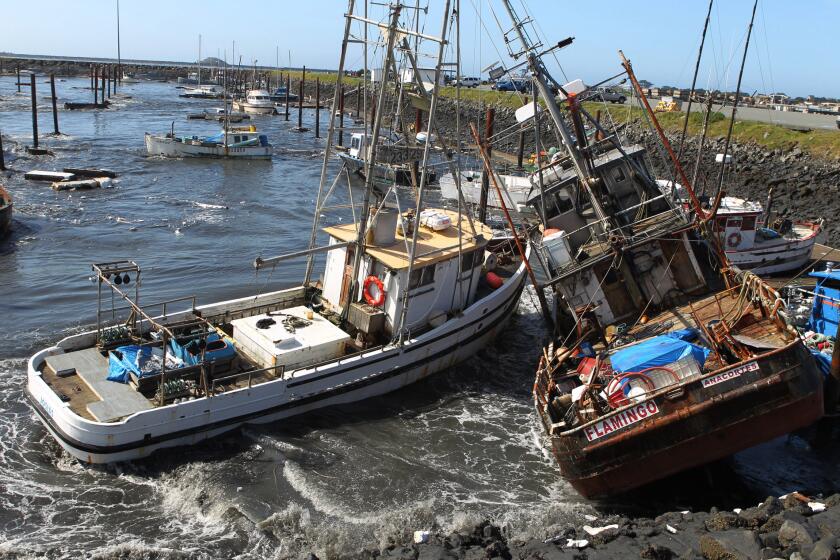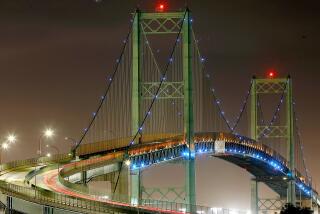Major bridges across California need probes to determine risk of a catastrophic collapse, authorities say

- Share via
- The National Transportation Safety Board called for 68 bridges across the country to undergo safety assessments.
- The bridges in need of safety assessments, according to the board, include seven bridges in California
A year after the collapse of the Francis Scott Key Bridge in Baltimore, an independent government agency urged the owners of seven bridges in California — including the landmark Golden Gate Bridge — to urgently assess their risk of a catastrophic collapse.
In a March 18 report, the National Transportation Safety Board identified a total of 68 bridges across the United States as not having undergone a vulnerability assessment based on recent vessel traffic. The bridges, it said, have an “unknown level of risk of collapse from a vessel collision.”
The report, part of the ongoing investigation into the Baltimore bridge collapse, said that the owners of the bridges — all built over navigable waterways frequented by ocean-going vessels — “are likely unaware of their bridges’ risk of catastrophic collapse from a vessel collision and the potential need to implement countermeasures to reduce the bridges’ vulnerability.”
Some of the California bridge owners told The Times that, after the Baltimore bridge collapse, assessments were underway.
The Golden Gate Bridge, Highway and Transportation District said in a statement that it was in “full compliance with all state and federal regulations, including federal bridge inspection and evaluation requirements” and that the famed bridge has “one of the most robust ship collision protection systems of any bridge on the West Coast.”
Still, the district noted, it hired a consultant earlier this year to conduct an assessment of the bridge’s south tower fender system’s structural capacity for ship collisions.
“The results of the study will be submitted to the Federal Highway Administration,” the district said.
John Goodwin, a spokesman for the Bay Area Toll Authority, which administers all toll revenue from toll bridges in the area that are owned and operated by Caltrans, told The Times that his agency began working last July with Caltrans and other groups to assess vessel traffic throughout the Bay, including the waterways under all seven of the state-owned toll bridges.
“I think it is smart that we assess the vulnerability of all of the bridges,” Goodwin said. “The risk of collapse is very small, but it is not zero. There’s no false sense of security there.”
Most of the seven California bridges identified as potentially vulnerable are in the Bay Area: the Richmond-San Rafael Bridge, the Carquinez Bridge, the Benicia-Martinez Bridge, the Antioch Bridge, the San Mateo-Hayward Bridge and the Golden Gate Bridge. The only one in Southern California is the San Diego-Coronado Bridge.

Caltrans, which owns the San Diego-Coronado bridge, has said the agency is reviewing the report’s recommendations.
“All state-owned bridges are regularly inspected to ensure strict structural safety and have been seismically retrofitted to the highest national standards,” a Caltrans spokesman told CBS affiliate KFMB-TV in a statement. “Caltrans is reviewing the National Transportation Safety Board’s recommendations and will respond to its request once the review is completed.”
Experts say the Baltimore collapse does not expose significant vulnerabilities in the major bridges near ports across California. The ports of Los Angeles and Long Beach handle about 40% of U.S. container imports from Asia.
The NTSB urged the owners of the seven California bridges to carry out a risk assessment based on guidance established by the American Assn. of State Highway and Transportation Officials, or AASHTO, more than 30 years ago.
If the bridge owners determine that a bridge has a high risk level, the agency recommended that they develop and implement a “comprehensive risk reduction plan” that identifies short- and long-term safety strategies.
Experts told The Times last year that California bridges were less at risk of toppling in a crash with an errant cargo ship than many bridges across the country, because their support columns have been retrofitted to make them withstand major earthquakes.
Still, Robert Dowell, an associate professor of structural engineering at San Diego State, said the Baltimore collapse demonstrated how vital it is to protect bridge piers from large container ships by installing or upgrading large fenders and ‘dolphins’ on the bridges that keep ships clear of bridges’ vital support piers.
The most recent risk assessment, outlined in maps published by the California Geological Survey, illustrate the devastation possible from extreme-but-realistic scenarios.
“The impact force with these very large container ships is huge,” Dowell said. “If you look at the big container ship that hit the bridge in Maryland, the top of the ship stuck way out from the bottom, so even if there was a fender around it, the top of the ship further up can impact the column part way up.”
In the 30 years since AASHTO introduced its guidelines, Goodwin said, vessel traffic in and out of the Bay Area has increased, and much bigger ships are plying its waters.
The busiest bridge in the Bay Area — the San Francisco-Oakland Bay Bridge — was not identified in the NTSB report. Goodwin said the bridge was left out because it already has been assessed and a $100-million project is set to begin some time after July to replace and upgrade the bridge’s fender system.
The upgrading of the Bay Bridge has been a regional priority after it was struck by ships in 2007 and 2013, Goodwin said. In both cases, the fenders absorbed and deflected the energy, but the 2007 collision, with an oil tanker, damaged the fenders and the ship, causing it to spill more than 53,000 gallons of oil.
The next generation of Bay Bridge fenders, Goodwin said, would be constructed with rubber, so they could better absorb the energy from a ship strike and protect the bridge and the vessels.
Even so, Dowell said all bridges evaluated before the Baltimore bridge collapse should be reassessed, even the Bay Bridge.
“Every single one of them should be looked at,” he said. “If the assessment was done more than a year ago, I would double back and take another look, because there was a lot of work that’s been done in the last year since the bridge collapsed in Maryland.”

On March 26, 2024, a 948-foot-long cargo vessel lost power as it left Baltimore’s port and rammed into a support pier of the Francis Scott Key Bridge, shattering the structure almost instantly. In 25 seconds, the entire bridge plunged into the Patapsco River.
Six members of a construction crew were killed.
The NTSB found that the Baltimore bridge was almost 30 times above the acceptable risk threshold for critical or essential bridges, according to guidelines established by AASHTO.
While the Golden Gate Bridge was built in 1937, the other California bridges that could be at risk were constructed in the 1950s through 1970s — long before AASHTO guidance was issued in 1991 for new bridges in response to the NTSB’s investigation of the Sunshine Skyway Bridge collapse in Florida.
In the March report, the NTSB urged the Federal Highway Administration to establish an interdisciplinary team with the U.S. Coast Guard and the U.S. Army Corps of Engineers to help the owners of potentially vulnerable bridges evaluate and reduce the risk of collapse.
Climate change continues to worsen the coastal storms that batter California’s aging piers. The result is frequent and expensive repairs.
The Federal Highway Administration and AASHTO cannot require bridge owners to evaluate a bridge’s risk of catastrophic failure from a vessel collision if it was designed before the 1991 guidelines were issued.
Even though existing bridges were not required to conduct a vulnerability assessment, the NTSB said in a news release that AASHTO recommended in 1991 — and again in 2009 — that all owners of bridges conduct such an assessment on existing bridges to evaluate their risk of catastrophic collapse.
If the Maryland Transportation Authority, which was not required to perform a vulnerability assessment to evaluate the Francis Scott Key Bridge, had conducted such an assessment based on recent vessel traffic, the NTSB noted, the state agency would have been aware that the bridge was above the acceptable risk and could have taken steps to lower the bridge’s risk of collapse and prevent deaths.
Dowell said the assessment of older bridges — and upgrading, if necessary — should be mandatory.
“I think they should be required to do a detailed assessment,” Dowell said. “And if the assessment, following the procedures that are laid out, show[s] that upgrades needs to be done or should be done, then I think they should be required to do it.”
More to Read
Sign up for Essential California
The most important California stories and recommendations in your inbox every morning.
You may occasionally receive promotional content from the Los Angeles Times.














